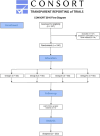Postoperative pain after single-visit root canal treatments in necrotic teeth comparing instruments' kinematics and apical instrumentation limits - a prospective randomized multicenter clinical trial
- PMID: 38643087
- PMCID: PMC11032596
- DOI: 10.1186/s12903-024-04225-6
Postoperative pain after single-visit root canal treatments in necrotic teeth comparing instruments' kinematics and apical instrumentation limits - a prospective randomized multicenter clinical trial
Abstract
Objectives: This prospective randomized multicenter clinical trial (PRMCT) investigated postoperative pain after single-visit root canal treatments in teeth affected by pulp necrosis (PN), and asymptomatic apical periodontitis (AAP) (with apical radiolucent areas) or normal periradicular tissues (without apical radiolucent areas) comparing different instruments' kinematics and apical instrumentation limits.
Methods: Before chemomechanical preparation, 240 patients/teeth were randomly distributed into four groups (n = 60) according to the instruments' kinematics (rotary or reciprocating) and apical instrumentation limits (with or without intentional foraminal enlargement [IFE]). After that, specimens were submitted to the same irrigation and obturation techniques, and the patients were referred to undergo the definitive restorations. No medication was prescribed, but the patients were instructed to take either paracetamol (750 mg every 6 h for three days) or ibuprofen (600 mg every 6 h for three days) in pain cases. Postoperative pain incidence and levels were assessed at 24-, 48-, and 72 h following treatment completion according to a verbal rating scale (VRS) following a score. The Kolmogorov-Smirnov test was applied to assess the normality of the data. Mann-Whitney U, Chi-square, Friedman's ANOVA, and Friedman's multiple 2 to 2 comparison tests were employed to identify potential significant statistical differences among the variables in the study groups (P < .05).
Results: Significant statistical differences were only observed among the groups considering tooth, periradicular status, and the occurrence of overfilling (sealer extrusion) (P < 0.00). Patients with teeth instrumented through rotary kinematics and without IFE experienced lower rates of postoperative pain; however, this difference was relevant only at 24 h (P < 0.05).
Conclusions: Postoperative pain was lower after using a rotary file system (Profile 04) inserted up to the apical constriction (AC). However, this finding was just statistically meaningful at 24 h.
Trial registration: This PRMCT was approved by the Human Research Ethics Committee of the Paranaense University - UNIPAR, Francisco Beltrão, PR, Brazil (CAAE. 46,774,621.6.0000.0109) on 02/09/2021. It was registered at The Brazilian Registry of Clinical Trials - ReBEC (RBR-3r967t) on 01/06/2023, was performed according to the Principles of the Helsinki Declaration and is reported following the Consolidated Standards of Reporting Trials Statement.
Keywords: Apical instrumentation limit; Asymptomatic apical periodontitis; Instruments' kinematics; Intentional foraminal enlargement; Postoperative pain; Root canal treatment.
© 2024. The Author(s).
Conflict of interest statement
The authors declare no competing interests.
Similar articles
-
Comparison of postoperative pain after foraminal enlargement of necrotic teeth using continuous rotary system and reciprocating instrument: A randomized clinical trial.Niger J Clin Pract. 2020 Feb;23(2):212-218. doi: 10.4103/njcp.njcp_436_19. Niger J Clin Pract. 2020. PMID: 32031096 Clinical Trial.
-
Postoperative pain after foraminal enlargement in anterior teeth with necrosis and apical periodontitis: a prospective and randomized clinical trial.J Endod. 2013 Feb;39(2):173-6. doi: 10.1016/j.joen.2012.11.013. Epub 2012 Dec 23. J Endod. 2013. PMID: 23321226 Clinical Trial.
-
Postoperative pain following endodontic irrigation using 1.3% versus 5.25% sodium hypochlorite in mandibular molars with necrotic pulps: a randomized double-blind clinical trial.Int Endod J. 2020 Feb;53(2):154-166. doi: 10.1111/iej.13222. Epub 2019 Oct 23. Int Endod J. 2020. PMID: 31563148 Clinical Trial.
-
The influence of kinematics of engine-driven nickel-titanium instruments on root canal shape assessed by micro-computed tomography: a systematic review.Acta Odontol Scand. 2019 Jul;77(5):347-358. doi: 10.1080/00016357.2019.1570331. Epub 2019 Feb 4. Acta Odontol Scand. 2019. PMID: 30712410
-
A systematic review and meta-analysis of randomized clinical trials comparing rotary canal instrumentation techniques with manual instrumentation techniques in primary teeth.Int Endod J. 2020 Mar;53(3):333-353. doi: 10.1111/iej.13233. Epub 2019 Nov 26. Int Endod J. 2020. PMID: 31587323
Cited by
-
Influence of number of visits on the outcome of endodontic treatment.J Conserv Dent Endod. 2024 Dec;27(12):1211-1220. doi: 10.4103/JCDE.JCDE_688_24. Epub 2024 Dec 10. J Conserv Dent Endod. 2024. PMID: 39959024 Free PMC article. Review.
-
ProDesign Logic Files Effect on Apical Foramen Wear and Shape Transformation After Foraminal Enlargement.Dent J (Basel). 2024 Oct 16;12(10):330. doi: 10.3390/dj12100330. Dent J (Basel). 2024. PMID: 39452458 Free PMC article.
References
-
- Burklein S, Arias A: Effectiveness of root canal instrumentation for the treatment of apical periodontitis: A systematic review and meta-analysis. Int Endod J 2022. - PubMed
Publication types
MeSH terms
LinkOut - more resources
Full Text Sources
Research Materials
Miscellaneous


